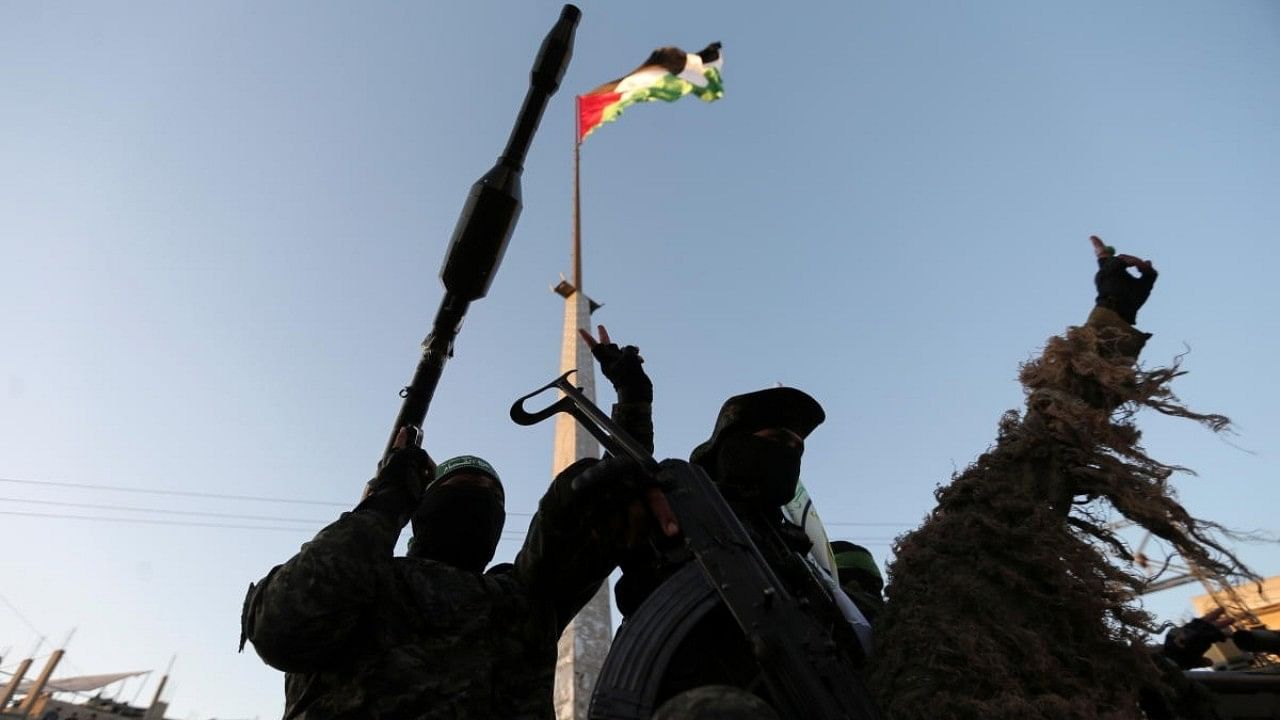
Palestinian Hamas militants.
Credit: Reuters Photo
Hamas, the group that controls the Gaza Strip and staged the brazen surprise attack on Israel on Oct 7, took scores of hostages after storming across the border in the deadly assault that also killed at least 1,400 people.
Here’s what we know about the captives.
How many hostages are there?
The Israeli military has told the families of 199 people that their loved ones had been taken hostage, according to Rear Adm. Daniel Hagari, the chief military spokesperson. A preliminary assessment had suggested that the number was closer to at least 150 people.
Israeli authorities have not yet publicly provided specific details about the identities of the victims, but military officials have said they included older people and children. Most were captured from small Israeli border towns.
The US State Department said that at least 13 Americans remained unaccounted for, but it was not clear how many were being held hostage.
President Joe Biden said that he had spoken with families of the missing, that he was committed to the recovery effort and that there is “no higher priority than the safety of Americans being held hostage around the world.”
The Pentagon has sent a small team of Special Operations forces to Israel to assist with intelligence and planning to help locate and try to rescue the hostages held by Hamas.
Officials from France and several other countries are also looking into reports that their citizens may be among the captives. “The murdered and the missing come from over 30 countries, including the United Kingdom,” Prime Minister Rishi Sunak of Britain said, adding that 10 British citizens were missing, some of whom are feared dead.
Who are they?
Some hostages appear to have been taken from their homes in the Israeli border communities that were overrun by Palestinian gunmen on Oct. 7. Others were most likely seized from a wooded area near the border where they had spent the night at a music festival.
Some are peace activists, part of collectives near the Gaza border whose members tend to be left of center and supportive of peace initiatives and Palestinian rights.
Distraught and fearful, relatives of those believed to be held hostage have turned to news organizations and social media platforms, sharing photographs of those who are missing and sharing videos online to solicit clues. Relatives have expressed despair at the lack of information, and they say they are terrified of what an expected Israeli invasion of Gaza might mean for their loved ones.
Where are they being held?
Abu Obeida, a spokesperson for Hamas’ armed wing, claimed in a statement on the Telegram app that it had hidden “dozens of hostages” in “safe places and the tunnels of the resistance.” The group is said to use an underground network of tunnels, much of it under civilian infrastructure, to travel undetected and move weapons.
Hamas has claimed that several hostages have been killed in Israeli airstrikes. The claims could not be independently verified.
How is Israel responding?
Amid widespread criticism about the lack of reliable information on the hostages, Prime Minister Benjamin Netanyahu of Israel announced the appointment of Gal Hirsch, a retired general, as coordinator for the captives and missing.
The military and the police also opened a joint center for families to register missing relatives, asking them to bring photographs and items from which the authorities could gather DNA samples.
What happens next?
The seizure of so many hostages suggests that Hamas may want to hold them as bargaining chips for a prisoner swap, and possibly to use them as human shields as Israel strikes back in Gaza. Ismail Haniyeh, the Hamas leader, had appeared to rule out prisoner exchanges as long as hostilities persist, saying, “This file will be not be opened until the end of the battle.”
UN Secretary-General António Guterres has appealed to Hamas to release the hostages immediately “without conditions.”
Last week, Hamas’ armed wing threatened to execute a civilian hostage every time an Israeli airstrike hit Gazans “in their homes without warning,” but has since made no announcements about harming them.
Thousands of Palestinians are being held in Israeli prisons, many of them convicted of security offenses or involvement in terrorism. Muhammad Deif, the leader of Hamas’ military wing, cited the detention of thousands of Palestinian militants in Israeli jails as one reason for the Oct 7 assault.
How have past hostage crises been resolved?
The issue of Israelis in captivity is a deeply emotional one in Israel.
In 2006, Gaza militants seized an Israeli soldier, Gilad Shalit, and Hamas held him for five years, until he was exchanged for more than 1,000 Palestinian prisoners, many of them convicted of deadly terrorist attacks against Israelis. Hamas has also been holding the remains of two Israeli soldiers killed in a 2014 war as well as two Israeli civilians who entered Gaza that year by foot and are believed to be alive.
Israel’s monthlong war against Hezbollah, the Lebanese Shiite militant organization, in 2006 began with a cross-border raid by Hezbollah and the abduction of two Israeli soldiers. The remains of the two soldiers were returned to Israel in 2008 as part of a prisoner exchange in which Israel handed over five Lebanese prisoners, including Samir Kuntar, who had been held for nearly three decades after being convicted in connection with a notorious attack.